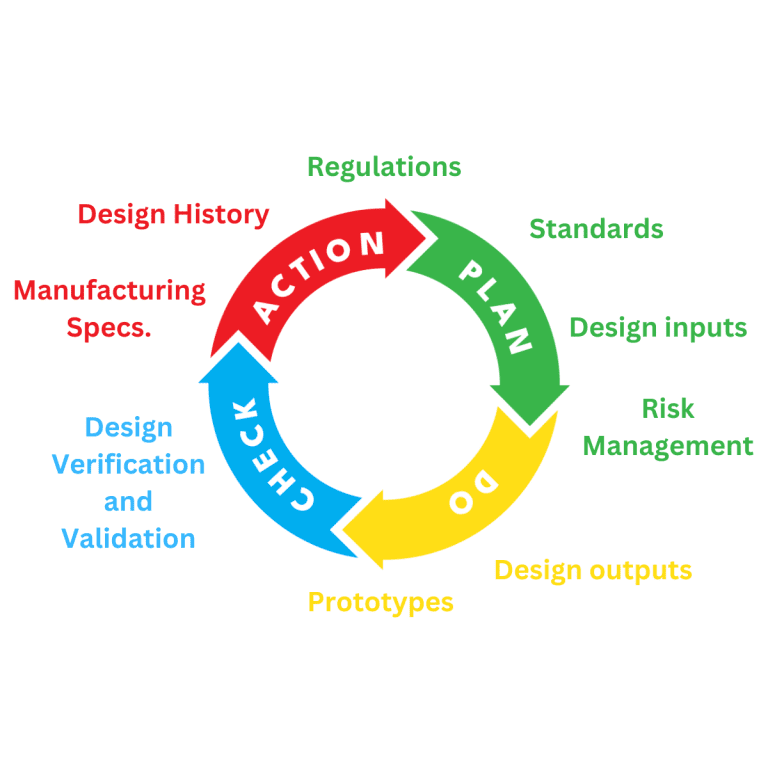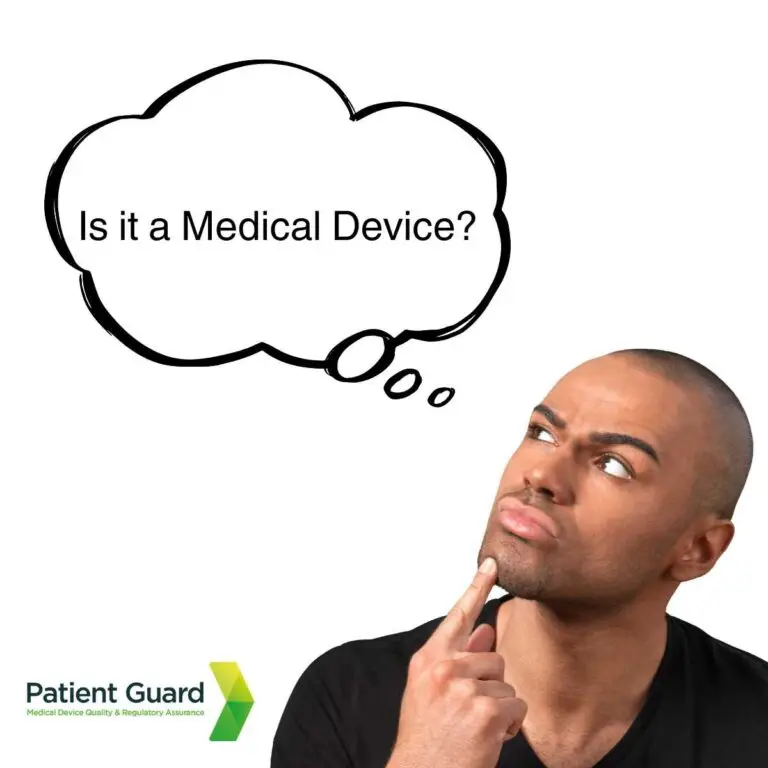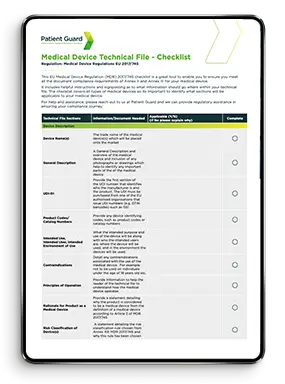Home » EU MDR Medical Device Classification Tool
EU MDR Medical Device Classification Tool
Our EU MDR Medical Device Classification software tool allows you to identify what class your medical device should be regulated as according to the EU MDR 2017/745 regulation

EU MDR Medical Device Classification Tool
Welcome to the Patient Guard Medical Device Classification tool for the EU MDR (EU 2017/745) regulatory framework. To get started, answer the following series of questions relating to your medical device, and the software tool will identify the classification of the medical device based on the rules of Annex VIII of the EU MDR 2017/745.
Previous Answers:
Is the product invasive?
Definition: ‘Invasive device’ means any device which, in whole or in part, penetrates inside the body, either through a body orifice or through the surface of the body.
Definition: ‘Body orifice’ means any natural opening in the body, as well as the external surface of the eyeball, or any permanent artificial opening, such as a stoma.
Is the product surgically invasive?
Definition: ‘Surgically invasive device’ means: (a) an invasive device which penetrates inside the body through the surface of the body, including through mucous membranes of body orifices with the aid or in the context of a surgical operation; and (b) a device which produces penetration other than through a body orifice.
Is the product intended for transient use?
Definition: ‘Transient’ means normally intended for continuous use for less than 60 minutes.
Is the product intended to supply energy in the form of ionising radiation?
Does the product have a biological effect or is it wholly or mainly absorbed?
Does the product administer medicinal products by means of a delivery system?
Is the product intended specifically to control, diagnose, monitor or correct a defect of the heart or of the central circulatory system through direct contact with those parts of the body?
Is the product intended for short-term use?
Definition: ‘Short term’ means normally intended for continuous use for between 60 minutes and 30 days.
Is the product intended specifically to control, diagnose, monitor or correct a defect of the heart or of the central circulatory system through direct contact with those parts of the body?
Is the product intended specifically for use in direct contact with the heart or central circulatory system or the central nervous system?
Is the product intended to supply energy in the form of ionising radiation?
Is the product intended to have a biological effect or is it wholly or mainly absorbed?
Is the product intended to be placed in the teeth?
Is the product intended to administer medicinal products?
Is the product intended to undergo chemical change in the body?
Is the product implantable or long-term surgically invasive?
Definition: ‘implantable device’ means any device, including those that are partially or wholly absorbed, which is intended: — to be totally introduced into the human body, or — to replace an epithelial surface or the surface of the eye, by clinical intervention and which is intended to remain in place after the procedure. Any device intended to be partially introduced into the human body by clinical intervention and intended to remain in place after the procedure for at least 30 days shall also be deemed to be an implantable device
Definition: ‘Long term’ means normally intended for continuous use for more than 30 days.
Is the product intended to be placed in the teeth?
Is the product intended to be used in direct contact with the heart, the central circulatory system, or the central nervous system?
Does the product have a biological effect or is it wholly or mainly absorbed?
Is the product intended to undergo chemical change in the body?
Is the product intended to administer medicinal products?
Is the product an active implantable device or an accessory to an active implantable device?
Definition: ‘active device’ means any device, the operation of which depends on a source of energy other than that generated by the human body for that purpose, or by gravity, and which acts by changing the density of or converting that energy. Devices intended to transmit energy, substances or other elements between an active device and the patient, without any significant change, shall not be deemed to be active devices.
Definition: ‘accessory for a medical device’ means an article which, whilst not being itself a medical device, is intended by its manufacturer to be used together with one or several particular medical device(s) to specifically enable the medical device(s) to be used in accordance with its/their intended purpose(s) or to specifically and directly assist the medical functionality of the medical device(s) in terms of its/their intended purpose(s)
Is the product a breast implant or surgical mesh?
Is the product a total or partial joint replacement?
Is the product a spinal disc replacement implant or implantable device that comes into contact with the spinal column?
Is the product an invasive device with respect to body orifices, intended for connection to a class IIa, class IIb or class III active device?
Definition: ‘invasive device’ means any device which, in whole or in part, penetrates inside the body, either through a body orifice or through the surface of the body.
Definition: ‘Body orifice’ means any natural opening in the body, as well as the external surface of the eyeball, or any permanent artificial opening, such as a stoma.
Definition: ‘active device’ means any device, the operation of which depends on a source of energy other than that generated by the human body for that purpose, or by gravity, and which acts by changing the density of or converting that energy. Devices intended to transmit energy, substances or other elements between an active device and the patient, without any significant change, shall not be deemed to be active devices.
Is the product an invasive device with respect to body orifices, intended for connection to a class I active device?
Definition: ‘invasive device’ means any device which, in whole or in part, penetrates inside the body, either through a body orifice or through the surface of the body.
Definition: ‘Body orifice’ means any natural opening in the body, as well as the external surface of the eyeball, or any permanent artificial opening, such as a stoma.
Definition: ‘active device’ means any device, the operation of which depends on a source of energy other than that generated by the human body for that purpose, or by gravity, and which acts by changing the density of or converting that energy. Devices intended to transmit energy, substances or other elements between an active device and the patient, without any significant change, shall not be deemed to be active devices.
Is the product an invasive device intended for transient use?
Definition: ‘invasive device’ means any device which, in whole or in part, penetrates inside the body, either through a body orifice or through the surface of the body.
Definition: ‘Transient’ means normally intended for continuous use for less than 60 minutes.
Is the product an invasive device intended for short-term use and used either in the oral cavity as far as the pharynx, in an ear canal up to the ear drum, or in the nasal cavity?
Definition: ‘invasive device’ means any device which, in whole or in part, penetrates inside the body, either through a body orifice or through the surface of the body.
Definition: ‘Short term’ means normally intended for continuous use for between 60 minutes and 30 days.
Is the product an invasive device intended for short-term use?
Definition: ‘invasive device’ means any device which, in whole or in part, penetrates inside the body, either through a body orifice or through the surface of the body.
Definition: ‘Short term’ means normally intended for continuous use for between 60 minutes and 30 days.
Is the product an invasive device intended for long-term use and used either in the oral cavity as far as the pharynx, in an ear canal up to the ear drum, or in the nasal cavity?
Definition: ‘invasive device’ means any device which, in whole or in part, penetrates inside the body, either through a body orifice or through the surface of the body.
Definition: ‘Long term’ means normally intended for continuous use for more than 30 days.
Is the product an invasive device intended for long-term use?
Definition: ‘invasive device’ means any device which, in whole or in part, penetrates inside the body, either through a body orifice or through the surface of the body.
Definition: ‘Long term’ means normally intended for continuous use for more than 30 days.
Is the product an active device? (Standalone software is considered an active device, for the purpose of this tool please answer "No" if your product is standalone software)
Definition: ‘active device’ means any device, the operation of which depends on a source of energy other than that generated by the human body for that purpose, or by gravity, and which acts by changing the density of or converting that energy. Devices intended to transmit energy, substances or other elements between an active device and the patient, without any significant change, shall not be deemed to be active devices.
Is the product an active device that is intended for controlling, monitoring, or directly influencing the performance of active implantable devices?
Definition: ‘active device’ means any device, the operation of which depends on a source of energy other than that generated by the human body for that purpose, or by gravity, and which acts by changing the density of or converting that energy. Devices intended to transmit energy, substances or other elements between an active device and the patient, without any significant change, shall not be deemed to be active devices.
Is the product an active device intended to emit ionizing radiation for therapeutic purposes, including devices which control or monitor such devices, or which directly influence their performance?
Definition: ‘active device’ means any device, the operation of which depends on a source of energy other than that generated by the human body for that purpose, or by gravity, and which acts by changing the density of or converting that energy. Devices intended to transmit energy, substances or other elements between an active device and the patient, without any significant change, shall not be deemed to be active devices.
Is the product an active device intended to control or monitor the performance of active therapeutic class IIb devices, or directly influence their performance?
Definition: ‘active device’ means any device, the operation of which depends on a source of energy other than that generated by the human body for that purpose, or by gravity, and which acts by changing the density of or converting that energy. Devices intended to transmit energy, substances or other elements between an active device and the patient, without any significant change, shall not be deemed to be active devices.
Is the product an active therapeutic device intended to administer energy to or exchange energy with the human body in a potentially hazardous way?
Definition: ‘Active therapeutic device’ means any active device used, whether alone or in combination with other devices, to support, modify, replace or restore biological functions or structures with a view to treatment or alleviation of an illness, injury or disability.
Is the product an active therapeutic device intended to administer or exchange energy?
Definition: ‘Active therapeutic device’ means any active device used, whether alone or in combination with other devices, to support, modify, replace or restore biological functions or structures with a view to treatment or alleviation of an illness, injury or disability.
Is the product an active device intended to emit ionizing radiation for diagnostic purposes?
Is the product an active device intended to image in vivo distribution of radiopharmaceuticals for the purpose of diagnosis and monitoring?
Is the product intended to illuminate the patient's body, in the visible spectrum for the purposes of diagnosis and monitoring?
Is the product an active device for diagnosis and monitoring which is intended to supply energy which will be absorbed by the human body?
Is the product an active device intended for monitoring of vital physiological parameters, where the nature of variations of those parameters is such that it could result in immediate danger to the patient?
Is the product an active device intended to allow direct diagnosis or monitoring of vital physiological processes?
Is the product an active device intended to administer and/or remove medicinal products, body liquids, or other substances to or from the body?
Is the product software?
Is the software intended to provide information which is used to take decisions with diagnosis or therapeutic purposes?
Could this lead to death or an irreversible deterioration of a person's state of health?
Could this lead to a serious deterioration of a person's state of health or a surgical intervention?
Is the software intended to monitor physiological processes?
Is the software intended for monitoring of vital physiological parameters, where the nature of variations of those parameters is such that it could result in immediate danger to the patient?
Is the product non-invasive?
Is the product intended for channelling or storing blood, body liquids, cells, or tissues for eventual infusion or introduction into the body?
Is the product a blood bag?
Is the product intended to modify the biological or chemical composition of body fluids, tissues, or cells?
Does the treatment involve filtration, centrifugation, or gas/heat exchange?
Does the product consist of substances used in vitro in contact with human cells or embryos?
Does the product contact injured skin or mucous membranes?
Is the product intended as a mechanical barrier, for compression, or absorption of exudates?
Is the product intended for injuries that have breached the dermis and can only heal by secondary intent?
Is the product principally intended to manage the micro-environment of injured skin or mucous membranes?
Find out more about medical device compliance and regulations

Software as a Medical Device (SaMD)
Software as a Medical Device (SaMD) has revolutionised the healthcare industry. From AI helping with medical image scanning to software

Medical Device Design and Development
Planning for the design and development of a medical device is a requirement of regulatory systems. All manufacturers of Medical

CE Marking Medical Devices
The CE marking of medical devices and in vitro diagnostic devices (IVDs) is a requirement of EU regulations (EU 2017/745

Is My Product a Medical Device?
When developing a new and exciting product it can be hard to know if it might fall under specific regulations.

Medical Device Software and AI – Revolutionizing Healthcare
Medical Device Software and artificial intelligence (AI) are not just buzzwords; AI is a transformative force that is reshaping the


